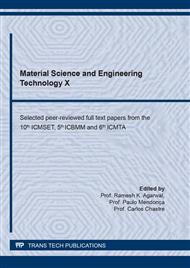p.35
p.41
p.47
p.55
p.61
p.71
p.77
p.85
p.91
Thermal Conduction: Computational Model and Engineering Applications
Abstract:
MATLAB was used to compute the effective thermal conduction of different samples of hard isotropic low porosity composites. The computational algorithms intended to use the Effective Medium Theory (EMT) Model to estimate the effective thermal conductivity (keff) of homogeneous composites. It estimates keff of a homogeneous mixture of components with known volume fractions and components’ conductivities. Starting with preliminary indicators to check the homogeneity conditions, we follow two approaches one for the measured samples and the other for a hypothetical sample with a certain specific desired property. One approach is to use preliminary indicators of surface homogeneity of the measured samples either via electron and/or via optical transmission microfilm scanning. The other approach is used for both measured and hypothetical samples by assuming a layered structure of parallel and series of slabs to compute upper and lower bounds of conduction. We used MATLAB to implement a fine precision computing algorithm to investigate the composite samples. The results predicted by the EMT model were examined for validation. The deviation of keff from the experiment for the homogenous samples is between 3 to 28% depending on the uniformity of distribution of phases within the composite matrix.
Info:
Periodical:
Pages:
61-70
Citation:
Online since:
February 2022
Price:
Сopyright:
© 2022 Trans Tech Publications Ltd. All Rights Reserved
Share:
Citation:


